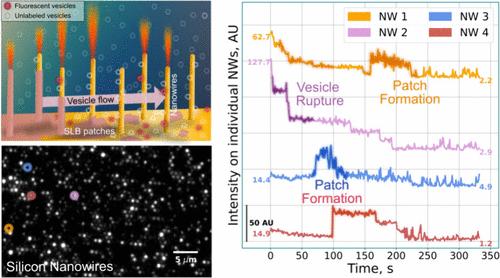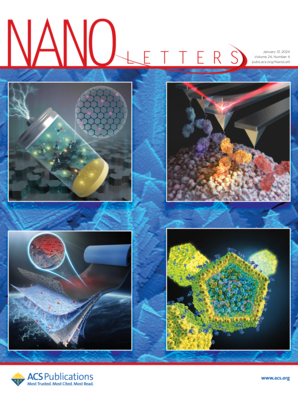Comparative Kinetics of Supported Lipid Bilayer Formation on Silica Coated Vertically Oriented Highly Curved Nanowires and Planar Silica Surfaces
IF 9.6
1区 材料科学
Q1 CHEMISTRY, MULTIDISCIPLINARY
引用次数: 0
Abstract
Supported lipid bilayers (SLBs), formed via lipid vesicle adsorption on highly curved silica surfaces, are widely used in biosensor applications and as models for curved cell membranes. However, SLB formation is often hindered on convex structures with radii comparable to the vesicles. In this study, lightguiding semiconductor nanowires (NWs), engineered for fluorescence signal enhancement, were used to compare the kinetics of SLB formation on vertically oriented NWs and planar silica surfaces. Time resolved fluorescence microscopy with single-molecule sensitivity revealed that while vesicle adsorption rates were similar on both surfaces lateral expansion of the SLB was up to three times faster on NWs than on the planar control. This accelerated expansion is attributed to lower energy penalties when SLBs spread along the cylindrical NWs compared with a planar surface, accompanied by accelerated SLB expansion driven by the merging of the SLB with excess lipids from vesicles accumulated on the NWs.

求助全文
约1分钟内获得全文
求助全文
来源期刊

Nano Letters
工程技术-材料科学:综合
CiteScore
16.80
自引率
2.80%
发文量
1182
审稿时长
1.4 months
期刊介绍:
Nano Letters serves as a dynamic platform for promptly disseminating original results in fundamental, applied, and emerging research across all facets of nanoscience and nanotechnology. A pivotal criterion for inclusion within Nano Letters is the convergence of at least two different areas or disciplines, ensuring a rich interdisciplinary scope. The journal is dedicated to fostering exploration in diverse areas, including:
- Experimental and theoretical findings on physical, chemical, and biological phenomena at the nanoscale
- Synthesis, characterization, and processing of organic, inorganic, polymer, and hybrid nanomaterials through physical, chemical, and biological methodologies
- Modeling and simulation of synthetic, assembly, and interaction processes
- Realization of integrated nanostructures and nano-engineered devices exhibiting advanced performance
- Applications of nanoscale materials in living and environmental systems
Nano Letters is committed to advancing and showcasing groundbreaking research that intersects various domains, fostering innovation and collaboration in the ever-evolving field of nanoscience and nanotechnology.
 求助内容:
求助内容: 应助结果提醒方式:
应助结果提醒方式:


